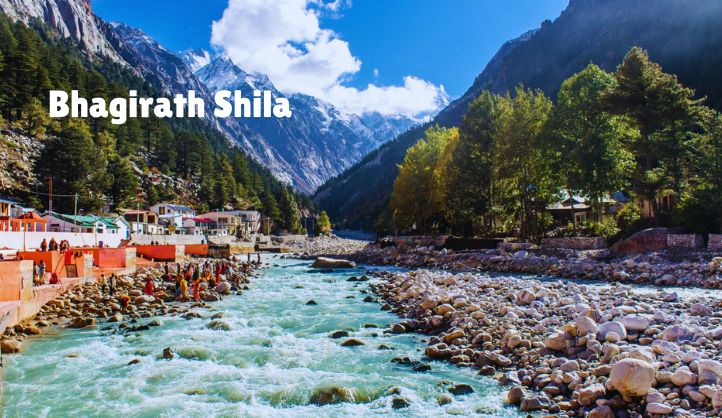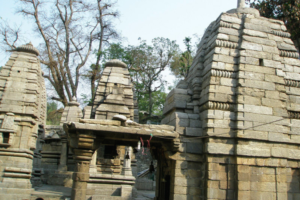In the towering peaks of the Himalayas, the holy town of Gangotri is a pilgrimage destination and a serene retreat for those seeking spiritual solace. Among the many sacred sites in Gangotri, Bhagirath Shila holds a special place in the hearts of devotees. This ancient stone is believed to be the very spot where King Bhagirath meditated to bring the River Ganga down to earth, a feat that has been immortalized in Hindu mythology.
Bhagirath Shila is more than just a stone; it symbolizes perseverance, devotion, and the enduring power of faith. This article delves deep into the significance, history, and spiritual importance of Bhagirath Shila in Gangotri, offering insights into why it continues to draw pilgrims from all corners of the world.
The Legend of King Bhagirath
To understand the significance of Bhagirath Shila, one must first delve into the legend of King Bhagirath, whose name is forever linked with the River Ganga. According to Hindu mythology, King Bhagirath was a descendant of the dynasty and the great-grandson of King Sagara. His story is of devotion and determination, as he undertook a monumental task to redeem his ancestors and bring the sacred Ganga to earth.
The Curse of King Sagara
King Sagara, an ancestor of Bhagirath, had 60,000 sons. These sons were sent on a quest to find a sacred horse that had been stolen during a ritual sacrifice. Their search led them to the hermitage of Sage Kapila, where they mistakenly accused the sage of stealing the horse. In his anger, Sage Kapila turned the 60,000 sons to ashes and cursed them to remain in a state of unrest until their souls were purified by the waters of a Ganga.
Bhagirath’s Austerities
Determined to redeem his ancestors, King Bhagirath undertook severe penance to appease Lord Brahma and request the descent of the Ganga from the heavens to the earth. His tapasya, or meditation, was so intense that it pleased Lord Brahma, who granted his wish. However, there was a challenge—if the Ganga descended directly onto the earth, her force would be so great that it would destroy everything in her path.
Lord Shiva’s Intervention
To prevent the earth from being overwhelmed, Bhagirath prayed to Lord Shiva, who agreed to absorb the mighty impact of Ganga’s descent. When Ganga finally descended, Lord Shiva caught her in his matted hair, allowing her waters to flow gently to the earth. Bhagirath then led Ganga to the ashes of his ancestors, purifying them and granting them moksha, or liberation. This sacred act is believed to have occurred at the very site of Bhagirath Shila.
Bhagirath Shila: The Sacred Stone
Bhagirath Shila is located near the Gangotri Temple, along the banks of the Bhagirathi River, which is the name given to the Ganga in her upper course. The stone is revered as the spot where King Bhagirath performed his penance, making it one of the holiest sites in Gangotri.
Spiritual Significance
For devotees, Bhagirath Shila is a powerful symbol of devotion, penance, and the transformative power of faith. It serves as a reminder of King Bhagirath’s unwavering determination and the lengths to which he went to bring the Ganga to earth. Pilgrims believe that offering prayers at Bhagirath Shila can cleanse their sins and bring them closer to spiritual liberation.
The Rituals at Bhagirath Shila
Pilgrims visiting Bhagirath Shila often perform rituals and offer prayers to honor King Bhagirath’s penance and seek blessings from the Ganga. The site is particularly significant during the annual Ganga Dussehra festival, which celebrates the descent of the Ganga to earth. Devotees bathe in the icy waters of the Bhagirathi River and perform pujas at Bhagirath Shila to seek the goddess’s blessings.
The Gangotri Temple
No visit to Bhagirath Shila is complete without a visit to the Gangotri Temple, one of the four sacred sites in the Char Dham Yatra. The temple is dedicated to Goddess Ganga and stands as a testament to the river’s divine origins.
History of the Temple
The Gangotri Temple is believed to have been built by Gorkha General Amar Singh Thapa in the early 18th century. The temple’s architecture reflects the simplicity and spiritual purity associated with the Himalayas, with its white marble facade blending harmoniously with the surrounding natural beauty.
The Temple’s Spiritual Atmosphere
The atmosphere at the Gangotri Temple is one of serenity and devotion. The sound of the Bhagirathi River flowing nearby adds to the spiritual ambiance, creating an environment that is conducive to meditation and reflection. Pilgrims visiting the temple often feel a deep sense of peace and connection with the divine.
The Bhagirathi River
The Bhagirathi River, which originates from the Gangotri Glacier, is named after King Bhagirath and is considered the most sacred stretch of the Ganga. The river’s journey from the glacier to the plains is symbolic of the spiritual journey that devotees undertake when they visit Gangotri and Bhagirath Shila.
The Origin of the Bhagirathi River
The Bhagirathi River originates from the Gaumukh Glacier, located about 18 kilometers from Gangotri. The glacier is situated at an altitude of 4,000 meters, and the trek to Gaumukh is a popular pilgrimage route for those who wish to witness the birthplace of the holy river.
The Confluence of Alaknanda and Bhagirathi
The Bhagirathi River merges with the Alaknanda River at Devprayag, where the two rivers together form the Ganga. This confluence is another important pilgrimage site, as it represents the union of two powerful rivers that have played a central role in the spiritual life of India.
The Pilgrimage to Bhagirath Shila
A pilgrimage to Bhagirath Shila is not just a journey to a sacred site; it is a journey of self-discovery and spiritual awakening. The trek to Gangotri, the serene environment, and the spiritual significance of Bhagirath Shila all contribute to an experience that leaves a lasting impact on the soul.
The Trek to Gangotri
For many pilgrims, the journey to Gangotri is as important as the destination itself. The trek through the Himalayas is challenging, but it offers an opportunity to connect with nature and experience the raw beauty of the mountains. The path is lined with stunning vistas, waterfalls, and lush forests, making it a spiritually uplifting experience.
The Spiritual Journey
Visiting Bhagirath Shila is often seen as a step towards achieving spiritual enlightenment. Pilgrims come to this sacred site to meditate, reflect, and seek blessings from the divine. The atmosphere of devotion, combined with the natural beauty of the surroundings, creates a powerful spiritual experience that resonates with visitors long after they leave.
The Architectural Marvels of Gangotri
While Bhagirath Shila and the Gangotri Temple are the primary attractions, the entire region of Gangotri is dotted with other architectural and natural marvels that add to the spiritual experience. These include ancient temples, serene ashrams, and awe-inspiring natural formations.
The Surya Kund and Gauri Kund
Surya Kund and Gauri Kund are two sacred water bodies near Gangotri that hold immense religious significance. Surya Kund is dedicated to the Sun God, while Gauri Kund is associated with Goddess Parvati. Pilgrims often take a holy dip in these kunds before offering prayers at Bhagirath Shila and the Gangotri Temple.
The Pandava Gufa
Located a short distance from Bhagirath Shila, the Pandava Gufa is a cave believed to have been the resting place of the Pandavas during their exile. The cave is surrounded by dense forests and offers a tranquil retreat for meditation and reflection.
Nearby Places to Explore Around Bhagirath Shila in Gangotri
Visiting Bhagirath Shila offers not only a spiritual experience but also the opportunity to explore several other captivating sites in and around Gangotri. The region is blessed with natural beauty and cultural significance, making it a perfect destination for pilgrims and nature enthusiasts alike. Here are some nearby places to explore during your visit to Bhagirath Shila:
1. Gangotri Glacier (Gaumukh)
The Gangotri Glacier is the source of the Bhagirathi River, which later becomes the Ganga. Known as Gaumukh, this glacier is shaped like a cow’s mouth, symbolizing its sacred status. The trek to Gaumukh is challenging but rewarding, offering breathtaking views of the Himalayan peaks and a chance to witness the origin of the holy river.
2. Pandava Gufa
The Pandava Gufa is a legendary cave believed to have been used by the Pandavas during their exile. Surrounded by dense forests, the cave provides a tranquil retreat for meditation and introspection. It’s a short trek from Gangotri and is ideal for those seeking a peaceful and spiritual environment.
3. Surya Kund and Gauri Kund
Surya Kund and Gauri Kund are two sacred water bodies near the Gangotri Temple. Surya Kund, dedicated to the Sun God, is a popular site for performing rituals, while Gauri Kund is associated with Goddess Parvati. The cascading waters of Surya Kund are particularly stunning and offer a serene spot for pilgrims to reflect and pray.
4. Kedar Tal
Kedar Tal is a pristine glacial lake situated at an altitude of 4,750 meters. The trek to Kedar Tal is challenging, with steep climbs and rugged terrain, but the rewards are immense. The lake is surrounded by towering peaks, including Thalay Sagar, Bhrigupanth, and Meru, offering a breathtaking panorama of the Himalayas.
5. Harsil
Harsil is a picturesque village known for its apple orchards, dense forests, and serene environment. Located on the banks of the Bhagirathi River, Harsil is often referred to as the “Mini Switzerland of India” due to its stunning natural beauty. The village offers a perfect retreat for those looking to escape the hustle and bustle of city life. Visitors can enjoy leisurely walks, explore local culture, and experience the tranquility of the Himalayas.
6. Dharali
Dharali is a quaint village located near Harsil, known for its terraced fields, pine forests, and the serene Bhagirathi River flowing by. The village is famous for its Rajma (kidney beans) and apples. Dharali is an excellent spot for nature lovers and those interested in experiencing the rural life of the Himalayas. The nearby Mukhba village is also significant as it houses the winter abode of Goddess Ganga.
8. Bhaironghati
Bhaironghati is a small settlement located at the confluence of the Jadh Ganga and Bhagirathi Rivers. The site is known for the Bhairav Nath Temple, dedicated to Lord Bhairav, a fierce form of Lord Shiva. The area is surrounded by dense forests and offers a serene environment for visitors. The Bhairav Nath Temple is particularly significant for those seeking protection on their spiritual journey.
Conclusion
Bhagirath Shila in Gangotri is more than just a stone; it is a living testament to the power of faith, devotion, and perseverance. It stands as a symbol of King Bhagirath’s unwavering dedication to his ancestors and his successful endeavor to bring the sacred Ganga to earth. For the millions of pilgrims who visit Gangotri each year, Bhagirath Shila offers a profound connection to the divine and a reminder of the spiritual journey that lies within us all.
FAQs About Bhagirath Shila in Gangotri
What is Bhagirath Shila, and why is it significant?
Bhagirath Shila is a sacred stone located near the Gangotri Temple in Uttarakhand. It is believed to be the spot where King Bhagirath meditated to bring the River Ganga down to earth from the heavens. His penance is said to have pleased Lord Shiva, who then released the Ganga from his matted locks. This site holds immense spiritual significance for Hindus and is an important part of the Char Dham pilgrimage.
How can I reach Bhagirath Shila in Gangotri?
Bhagirath Shila is located near the Gangotri Temple in the town of Gangotri, Uttarakhand. To reach Gangotri, you can take a bus or taxi from Rishikesh, Haridwar, or Dehradun to Uttarkashi. From Uttarkashi, Gangotri is about 100 km away, accessible by road. Once in Gangotri, Bhagirath Shila is a short walk from the temple, making it easily accessible for pilgrims and tourists.
What is the best time to visit Bhagirath Shila?
The best time to visit Bhagirath Shila is during the summer months, from May to October, when the weather is pleasant and the roads are accessible. The Gangotri Temple opens in May and closes around Diwali in October or November, depending on the weather. During these months, the region experiences moderate temperatures, making it ideal for pilgrimage and trekking.
Is there any trekking involved to reach Bhagirath Shila?
No trekking is required to reach Bhagirath Shila as it is located near the Gangotri Temple, easily accessible on foot. However, if you plan to explore nearby attractions like the Gaumukh Glacier or Tapovan, trekking will be involved. These treks can be challenging and require proper preparation and fitness.
Are there accommodations available near Bhagirath Shila?
Yes, there are several accommodations available in Gangotri, ranging from budget guesthouses to more comfortable hotels. Pilgrims and tourists can find a place to stay close to the temple, allowing easy access to Bhagirath Shila and other nearby attractions. It’s advisable to book accommodations in advance, especially during the peak pilgrimage season.
What other places can I visit near Bhagirath Shila?
There are several noteworthy places to explore near Bhagirath Shila, including:
- Gangotri Glacier (Gaumukh): the source of the Bhagirathi River, about 18 km from Gangotri.
- Pandava Gufa: A legendary cave located 1.5 km from Gangotri.
- Surya Kund and Gauri Kund: sacred water bodies near the Gangotri Temple.
- Harsil: is a scenic village 25 km from Gangotri.
- Kedar Tal: is a pristine glacial lake, 18 km from Gangotri.
- Bhaironghati: A small settlement with the Bhairav Nath Temple, 10 km from Gangotri.
Is Bhagirath Shila accessible during the winter months?
No, Bhagirath Shila is not accessible during the winter months. Gangotri experiences heavy snowfall, and the temple and surrounding areas are closed to visitors from November to April. The temple and Bhagirath Shila reopen in May when the snow melts and the region becomes accessible again.
What rituals or prayers are performed at Bhagirath Shila?
Pilgrims visiting Bhagirath Shila often perform rituals and prayers to honor the efforts of King Bhagirath and to seek blessings from the River Ganga. Offering flowers, lighting lamps, and reciting prayers are common practices. The site is considered highly auspicious, and many pilgrims believe that praying here can cleanse one’s sins and grant spiritual merit.





